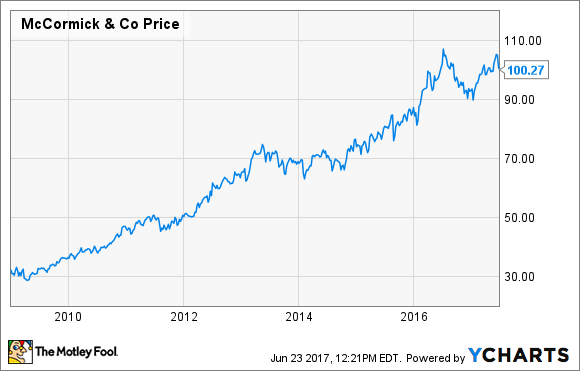McCormick & Company (MKC 1.68%) has an impressive stock chart. Its price has more than tripled since 2009. In addition the company has increased its quarterly dividend for 31 consecutive years. We all know it as the king of seasonings and spices yet it is surprising to learn how such an old industry is adopting to the change brought about by the age of the internet. Here is a look at the company, its business, and why you may want to add it to your portfolio.
Cash return to shareholders
The company practices a balanced approach to its use of cash. A portion of its free cash flow is used to grow the business and a portion is returned to shareholders. Below is a look at some of the numbers for earnings per share and dividends paid over the past few years. The important point is that the company makes money year after year and can easily support the dividends it pays shareholders from its profits. Its dividend payout ratio is less than 50% for most years.
| Metric | 2017 (estimated) | 2016 | 2015 | 2014 | 2013 | 2012 |
|---|---|---|---|---|---|---|
| Annual dividend payout | $1.88 | $1.76 | $1.63 | $1.51 | $1.39 | $1.27 |
| Earnings per share diluted | $4.06 | $3.69 | $3.11 | $3.34 | $2.91 | $3.04 |
| Dividend payout ratio | 46% | 48% | 52% | 45% | 48% | 42% |
Data source: McCormick. EPS estimate for 2017 is based on the midpoint of guidance.
McCormick is the lead dog in the pack
McCormick has been in business since 1889. It markets its products in both the consumer and industrial segments of the market. Consumer packaged retail spices and seasoning are an $11 billion worldwide market and McCormick has a 20% market share, four times its next-largest competitor.
If you are thinking this is an old company that has risen to the top and is simply coasting on its laurels, you would be mistaken. McCormick is innovating in both a product and a marketing sense. As a demonstration of its ability to stay fresh, 9% of its overall sales revenue in 2016 was comprised of products it introduced in the past three years.
Below is a table showing how the company's 2016 revenue is divided between its consumer segment, which supports retail shoppers like us, and the industrial segment, which sells to food manufacturers.
| Market Segment | Americas | EMEA | Asia-Pacific | Percent of Total Revenue | Percent of Total Operating Income |
|---|---|---|---|---|---|
| Consumer segment | 41% | 13% | 8% | 62% | 75% |
| Industrial segment | 26% | 7% | 5% | 38% | 25% |
Data source: McCormick. EMEA = Europe, the Middle East, and Africa.
The company's strategy
McCormick has a goal of growing its sales on a constant currency basis 4% to 6% per year on average over the long term. It strives for balance by having growth equally distributed across its base business, new products, and growth through acquisition.
The company has fully embraced the move to organic and natural products coupled with a focus on sustainable supply chain from source to table. There are five principles that the company highlights for its business:
- Passion for flavor: Inspire healthy choices
- Power of people: A high-performance culture
- Taste you trust: Quality from source to table with a focus on food safety
- Driven to innovate: How the company differentiates its brands
- Purpose-led performance: Grow the business by doing the right thing with responsibility to people, community, and planet
The supermarket is the best place to find what McCormick refers to as its consumer base business. The company wants to make its products as pure as possible. You may notice that many are labelled gluten-free, organic, non-GMO, and BPA-free. Packaging is changing to keep products fresher longer and to be recyclable after use.
On the marketing side, the company is trumpeting its efforts to help the environment, provide pure products to its customers, and create a sustainable supply chain that helps farmers and locals from where the products are sourced.

Image source: McCormick.
As McCormick likes to say, "Pure tastes better"
Consumers view the McCormick brand for spices as the best or one of the best 80% of the time. That is powerful brand recognition. One-third of McCormick website traffic is driven by millennials. These are folks who want to enjoy a cooking experience, and McCormick's marketing highlights its focus on the purity of its products and the joy of cooking.
McCormick understands that shopping trends are focused on digital, with 78% of shopping trips starting online and 68% of millennial moms watching how-to videos when cooking. E-commerce is the fastest-growing shopping space, and in 2016 McCormick's U.S. consumer sales in alternate channels grew more than 250% as compared to the traditional grocery or retail store.
Foolish conclusion
This company has a lot going for it: a stable business with a commanding lead in the market. Add a tasty dividend to the mix, and you have a stock and a company that you can hold onto for a long time.






